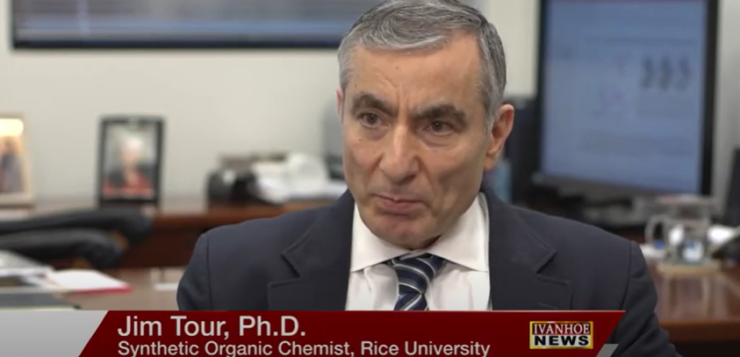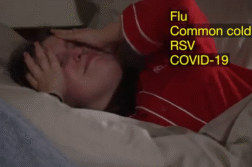James Tour, PhD, T.T and W.F. Chao Professor of Chemistry, Computer Science, Materials Science and Nano Engineering at Rice University, explains a new way to kill superbugs.
Can you summarize the actual usage and mechanics of your molecular drills?
TOUR: It is nano machines killing super bugs.
Can you explain how the sheathing of the bacteria is difficult to get into, and will this help deliver antibiotics better?
TOUR: We’ve made these nano machines that are single molecules. They’re about 1 nanometer in diameter and designed such that when we shine a light on them, they will rotate unidirectionally 3 million rotations per second. What we do is we can have them associate with a cell surface and then activate them by shining a light. That turns them on. Then, they drill into a cell. We’ve done this before with eukaryotic cells, which are like human cells. But now, we’ve extended this to bacterial cells. Bacterial cells are much harder to get into because unlike a human cell or a cancer cell that has just a lipid bilayer, it has a lipid bilayer and below that it has a proteoglycan which is a protein layer that’s interweaved with carbohydrates that’s very rigid. Then, below that it has another lipid bilayer which is much more complex and harder to get through. That’s one of the reasons it’s hard to kill bacteria. This just drills right into them. Now we can kill the bacteria in two ways. Either we drill enough holes in them with these nano machines that they die, or we can use a small amount of nano machines in the presence of outdated antibiotics. The antibiotics that were held out because these cells had evolved protections to protect themselves against this by building things on the surface that kept these molecules out, now we pop holes with the nano machines. Then, the drugs get in through that and kill the bacteria. This is important because it allows us to use antibiotics that have already been outdated that the bacteria thought they’d already built a defense to. Every five-year period in the 1980’s we were generating about 16 new antibiotics. Now, we’re generating one to two every five-year period. Why is that? Number one, because there’s no money in bacteria in antibiotic development and there’s no money because the bacteria evolves so quickly. They build up immunity so quickly to these that you’d never accrue back your money. The billion and a half dollars that you spent making and marketing this drug, in four years, the bacteria figured it out and so it becomes obsolete. If we can take this whole cadre of IV antibiotics that we have where many of them were held out of the cell because of the bacterial cell surface, we can just pop holes and use these. This is a great advance because it’s slated to kill 10 million people per year by the year 2050. So, by the time my children are my age, 10 million people a year are going to be dying because of super bacteria if we do not figure out a way to kill them. What’s nice about the nano machines is it’s a mechanical effect and not a chemical effect. They can’t build up a resistance to the nano machine. So, that’s why we see high prospect for these.
Explain how they get surrounded so that the bacteria can’t penetrate? What is happening that the antibiotics can’t get to it?
TOUR: There are two primary mechanisms by which antibiotics stop working. One is that the bacteria will recognize that drug on its surface and has built up a system that won’t let that drug in. Initially, it let in the drug thinking that it was a beneficial molecule and ended up dying as a result. So, they built up these probes on them, these sensors, that now sense that molecule and refuse its entry. It’s in those cases where the nano machines come in, drill a hole, bypass the sensor elements, and bypass the proteins on the surface that open to let things in. It drills right through the three-layer structure and lets things in. There’s another type of resistance where once molecules get in, the bacteria can have enzymes that degrade the molecules. In those cases, the nano machines don’t help because the drugs are recognized on the inside. It’s in the cases where the antibiotics are recognized on the surface that we can bypass that with the nano machines.
Is the recognition on the inside another development in the timeline of “can’t beat the superbug” kind of thing?
TOUR: It could be. The superbugs had developed a surface recognition that keeps some of these antibiotics from getting in. They haven’t developed yet something that deals with the antibiotics once they get in because they’re already keeping them out. We bypass that mechanism. But we have many drugs that can’t get in. So, we are going to be able to get past that, at least for many years to come, with these nano machines. We can also use a higher concentration of the nano machines and have them pop enough holes in the bacterium that it kills it. So, we could do it either way. The nano machines themselves can target to a specific cell type. That we’ve done. We can take the nano machine and hook on a small protein, a peptide, and can recognize a particular cell surface type. Then, it’ll go to just specifically that cell.
How would the decision be made on how to approach that? Are we going to drill it full of holes or drill it slightly and let the drugs in?
TOUR: It probably depends on the concentration of the nano machines that we want to use. For example, say it’s on the skin, Staphylococcus, and we have easy access to it. We would probably use a larger concentration of it and kill everything. If it’s a bloodborne bacteria, we don’t want to put so much of the nano machines in systemic. We’d probably just use a small amount and target the cell surface and have them sit there. Then, we would introduce the drugs. Because we activate these with light, the blood would be pumped out much like a dialysis unit. Blood goes out and goes through a filtration system. In this case, it would go through a box that has light activators. As it’s passing through these coils, it would drill into the bacteria and end up going back in the body and continue around for a few hours to knock out the bloodborne bacteria. Then, we let the antibiotics take care of it from there.
How does something like this even get thought of, and, how do you figure out shining light through it is going to work?
TOUR: There are certain classes of molecules that were designed to spin unimolecular when you shine a light. In fact, the Nobel Prize was won a few years ago for the device. So, we took a known class of molecules and put them in cars, building nano cars and using them as motors, and thought we could drill into these cells. It turned out to work. We redesigned it so that it would interact with the cells. It was more of a subtle redesign. That’s usually what happens with science. You see one thing, you take it, you redesign it and apply it somewhere else. Then, we started putting peptides on it and showing that it could interact with cells and destroy them.
When you look at the drill up close, what does it physically look like?
TOUR: It looks like a cross molecule, and when you shine a light, one of them will just start spinning. It spins three million rotations per second, which is much faster than any macroscopic motor could ever spin. At the nanometer scale, and at the molecular scale, these sort of quantum effects allow this to happen. You need that rapid spinning to drill through the bilayer because a bilayer of a eukaryotic or mammalian cell is about 10 nanometers. These are only about 1 nanometer, so they must drill for a while to get through. These things must stay operational and can take one to two minutes to drill through.
In a chronological timeline, where are we with development to implementation?
TOUR: A company called Nanorobotics is licensing this and signing the agreement now to take this and begin to transition through the next phases. Generally, from a laboratory to implementation, it can take 12 to 14 years. But in cases where there is dire need, these things can be accelerated. That’s the hope that you choose a target where there’s a dire need and see the acceleration. There are all sorts of different mechanisms for doing that. One can choose an orphan disease where there’s very few people that get the disease. And, these things can be fast-tracked because there’s generally no monetary stimulus for a company to want to do it because the number of people who have the disease might be on the order of a thousand people. So, you’re never going to see your money back. They allow smaller companies to develop these. If it can get approved for that, then you can cross list it for any other application. So, there’s a lot of freedom. Say we chose pancreatic cancer, or glioblastoma of the brain, where the lifetime from diagnosis to death might be about 12 to 18 months even with surgery. In these sort of cases, you can get things approved much faster because for those who have it, they’re willing to try whatever is available because the other option of death is the sure outcome.
If you were to do this on a human subject, is there any associated pain?
TOUR: We’ve never done it on a human, only on animal skin, and presumably there’s very little pain during the action. But, because you will be tearing up tissue, there would be some irritation on the skin. You can see these drilling into the surface in that several hundred microns of the skin is just shredded. It would be much like an abrasion. Not any extreme pain, but if I took a rough object and rub it on my skin and take off 200 microns, it would be a little sore and red for a few days. We’re even looking at easier places to bring this in, like dermatology. We’re looking at simple targets of going after things in dermatology because it’s easier to get things approved because they’re staying either on the surface of the skin or just a few hundred microns into the skin. For example, acne is caused by bacteria. There are already products on the market that apply a light to the pimple. So, this would be applying an ointment that has the molecules in it, the nano machines in it, then applying the light. It’s a very small transition beyond what’s been done, but it could have a profound effect. We’ve also considered it for pre-melanoma because with melanoma there’s the removal of the skin. With pre-melanoma, this could be done more efficiently by just having the nano machines drill right in and tear apart those precancerous cells. You want to get those before the melanoma gets too deep and hits the lymphatic system and then spreads.
How did you make that leap from something that works in vehicles to something that would work in the human body?
TOUR: At first, I thought the nano machines were really going to be too small to work in the body and we’d need something larger, something protein-like. But then I thought if these can really be like a drill, maybe we can drill into cells and kill them. I probably first started thinking about that in 2010. To really monitor and show that it works, I would have to work with a collaborator because we make molecules and study the molecular actions, but don’t work with cells. So, you must work with somebody who’s a cell expert also knows how to do imaging and watch the imaging and see this drilling into a cell. I tried working with several other groups and they were unable to demonstrate these working. In 2015, I visited Durham University in the UK, and was asking collaborators there. One guy said, I can’t do that, but I have a very good postdoc who’s starting his career and technically extremely good, and that’s what you need. We had a conversation, I sent him some molecules and within a few months, he had it working. We had our first demonstration of its working and then a couple of years later, we published our first paper on the topic. It got a lot of press and it showed the interaction. Now, we’ve published several more papers on how these are working in whole organisms.
In an ideal world, what would be your complete end goal?
TOUR: Now that it’s turning over to a company, there’ll be private assets behind this. They care less about the science than they do about driving this product to market. So, things are going to accelerate. We’ll have more direct funding to do this and there’ll be more people directed toward it. If things move very quickly, it would probably be about a five-year period. And that would be on the fast track.
What would you say about superbugs?
TOUR: Superbugs, in my mind, I would want to use as one of the first targets. Corporately, they have a different analysis. They look at different markets and different market sizes. So, what I’d like to do is first go in via dermatology. Just do it on the skin. Things can be accepted sometimes even in 18 months for dermatology. Once it has an entry there and we show its nontoxicity, then start working on staph infections like Staphylococcus which is a serious problem and very hard to stop. We’re already looking at mouse models where there’s induced Staphylococcus on the skin. If that takes off and it’s already approved for dermatology, that could be a fast track.
END OF INTERVIEW
This information is intended for additional research purposes only. It is not to be used as a prescription or advice from Ivanhoe Broadcast News, Inc. or any medical professional interviewed. Ivanhoe Broadcast News, Inc. assumes no responsibility for the depth or accuracy of physician statements. Procedures or medicines apply to different people and medical factors; always consult your physician on medical matters.
If you would like more information, please contact:
Mike Williams, Senior Media Relations Specialist
Rice University
713-348-6728
Sign up for a free weekly e-mail on Medical Breakthroughs called First to Know by clicking here




